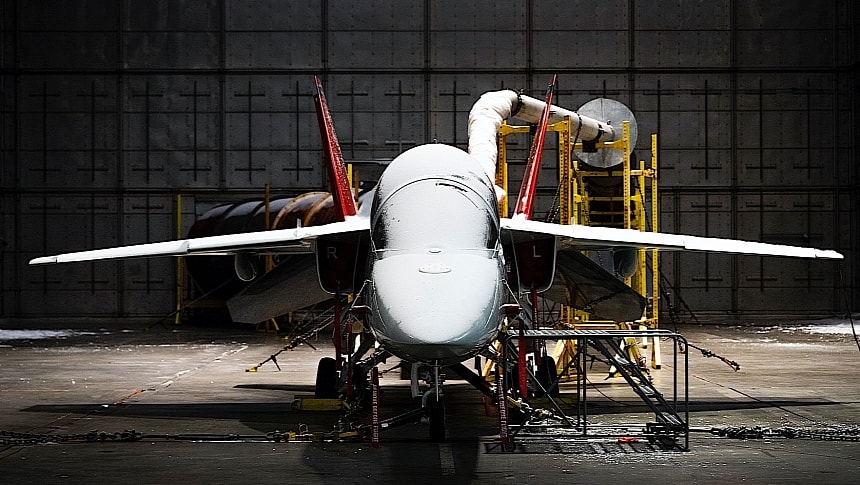In the world of military aircraft the T-7A Red Hawk is the junior. Made by Boeing and Saab, the plane has only recently reached the hands of U.S. Air Force (USAF) pilots, who are currently hard at work validating the machine for its coming deployment in the hands of all of America's military aviators.
That's right, all of them, as the T-7A Red Hawk is the plane that will eventually train them all. Meant to replace the aging T-38 Talon in the USAF training schools' arsenal, it is moving closer and closer to operational status.
We last got word of the Red Hawk back in November last year, when Boeing moved an example of the breed, under its own power and through the sky, for a distance of 1,400 miles (2,253 km), from an undisclosed location to the Edwards Air Force Base in California.
It is there where the first trainer aircraft will be put through their paces at the hands of military pilots, and from where we'll probably get more and more news in the coming months. But until we do, here's something coming from the McKinley Climatic Laboratory.
Located at the Eglin Air Force Base in Florida, the facility is the go-to place if you want to perform weather testing on weapons and weapons platforms. The 55,000 square feet (5,100 square meters) location can mimic the most extreme environmental conditions on the planet, from the hotness of arid deserts to extremely low temperatures. Why, it can even simulate solar radiation and rapid decompression.
It is in this place where a T-7A Red Hawk was put through its paces for about a month, being cooked and cooled at temperatures ranging from minus 25 to 110 degrees Fahrenheit (minus 32 to 43 degrees Celsius), and going from one type of environment to another in days.
The USAF says the goal of the procedures was to "verify the new aircraft's sustainability in any operational environment" its operators are likely to encounter across the country.
We're not told precisely how the testing went, but we're assuming all worked according to plan. That is judging by the fact the USAF will now send the plane back to Boeing "to ensure the aircraft's technical orders are safe and accurate for the operators and maintainers that will interact with it."
The T-7A Red Hawk is a single-engine aircraft that uses a General Electric turbofan rated at 17,000 pounds of thrust. It can travel at speeds of over 800 mph (1,300 kph) and can reach altitudes as high as 50,000 feet (15,000 meters).
Boeing has been tapped by the military to manufacture 351 of these planes, as well as simulators and support hardware, in exchange for $9.2 billion.
We last got word of the Red Hawk back in November last year, when Boeing moved an example of the breed, under its own power and through the sky, for a distance of 1,400 miles (2,253 km), from an undisclosed location to the Edwards Air Force Base in California.
It is there where the first trainer aircraft will be put through their paces at the hands of military pilots, and from where we'll probably get more and more news in the coming months. But until we do, here's something coming from the McKinley Climatic Laboratory.
Located at the Eglin Air Force Base in Florida, the facility is the go-to place if you want to perform weather testing on weapons and weapons platforms. The 55,000 square feet (5,100 square meters) location can mimic the most extreme environmental conditions on the planet, from the hotness of arid deserts to extremely low temperatures. Why, it can even simulate solar radiation and rapid decompression.
It is in this place where a T-7A Red Hawk was put through its paces for about a month, being cooked and cooled at temperatures ranging from minus 25 to 110 degrees Fahrenheit (minus 32 to 43 degrees Celsius), and going from one type of environment to another in days.
The USAF says the goal of the procedures was to "verify the new aircraft's sustainability in any operational environment" its operators are likely to encounter across the country.
We're not told precisely how the testing went, but we're assuming all worked according to plan. That is judging by the fact the USAF will now send the plane back to Boeing "to ensure the aircraft's technical orders are safe and accurate for the operators and maintainers that will interact with it."
The T-7A Red Hawk is a single-engine aircraft that uses a General Electric turbofan rated at 17,000 pounds of thrust. It can travel at speeds of over 800 mph (1,300 kph) and can reach altitudes as high as 50,000 feet (15,000 meters).
Boeing has been tapped by the military to manufacture 351 of these planes, as well as simulators and support hardware, in exchange for $9.2 billion.












